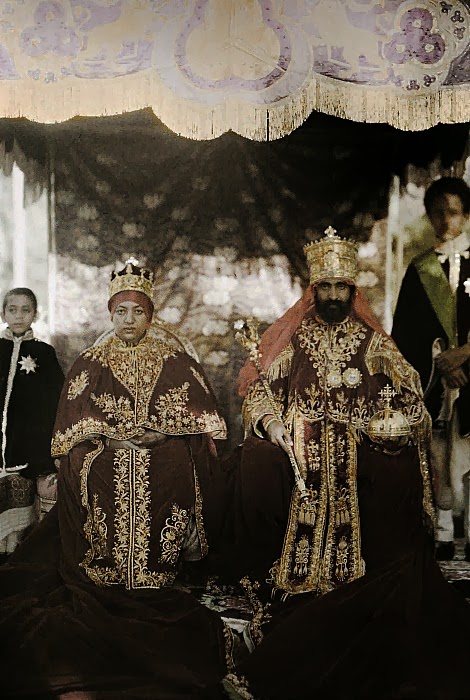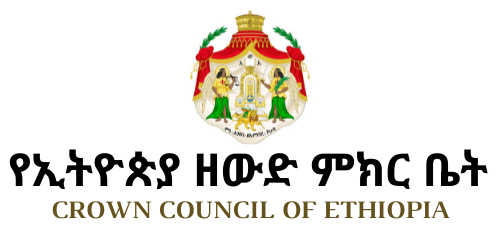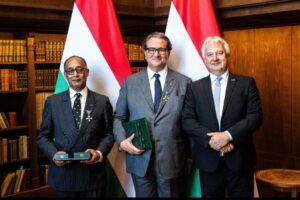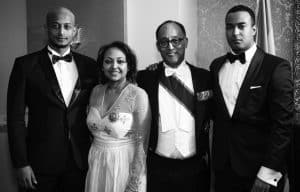Enkutatash
23 Tikimt 2015 / 3 November 2023
On the 23rd Day of the Month of Tikimt, 1923 on the Ethiopian Calendar, and November 2, 1930, on the Gregorian Calendar, Emperor Haile Selassie I was crowned King of Kings of Ethiopia at Addis Ababa’s Cathedral of St. George. This year, we celebrate the anniversary on November 3, 2023, due to Ethiopian leap year pushing the calendar one day forward until it readjusts with Gregorian leap year in February. This is a look back on that glorious day.

Through centuries, Ethiopia witnessed many Imperial successions as Emperor replaced Emperor over 30 centuries. Emperor Haile Selassie’s coronation however was a particular historic milestone for several reasons. Firstly, he succeeded the only woman to reign in her own right since ancient times, his second cousin, Empress Zewditu. When the nobility gathered in September of 1916 and deposed Lij Iyasu Mikael, they had enthroned Zewditu as successor to her father Emperor Menelik II. As she was childless and past her childbearing years, it was decided that the next heir would be Ras Tafari Makonnen, her paternal second cousin who became both Crown Prince and Regent. It was the first time in the history of Ethiopia that a monarch was crowned with a designated heir apparent in the position of regent. Now, the regent was succeeding to the throne himself. Indeed, Emperor Haile Selassie may have been crowned Emperor in 1930, but he had taken on state responsibility in 1916.
Ethiopia had been opening up to the outside world since the reign of Emperor Menelik II in a way that it hadn’t before. Ever since the victory at the Battle of Adwa, the great powers of the day had all become very interested in Africa’s sole surviving pre-colonial Empire. Diplomatic relations had been established and the pursuit of commercial and political ties was sought by not just colonial powers, but countries like Japan and the United States. Thus, when Emperor Haile Selassie acceded to the Imperial throne on April 2nd, 1930, and preparations began for his coronation, these new ties were considered when a guest list was drawn up for the upcoming coronation. Invitations were sent to all the crowned and non-crowned heads of state, but traditionally, monarchs did not attend the coronation of another monarch, but instead sent a representative in their stead. This tradition was only changed in this century. The coronation of Emperor Haile Selassie attracted an illustrious list of attendees. Of the world’s monarchies, King George V of the United Kingdom, Emperor of India, was represented by his son Prince Henry Duke of Gloucester. King Vittorio Emanuelle III of Italy was represented by his cousin, Prince Fernando of Savoy Prince of Udine and future Duke of Genoa. Other monarchs sent senior nobles and diplomats. King Albert II of the Belgians sent diplomat M. Gérard, King Gustav V of Sweden sent Baron H.K. C. Bildt, Queen Wilhelmina of the Netherlands sent Jonkheer Hendrik Maurits van Haersma de With, Emperor Hirohito of Japan sent diplomat Isaburo Yoshida, King Fuad I of Egypt sent Muhammad Tawfiq Nasim Pasha. The republics of the world were also well represented. France sent Marshal Louis Franchet d’Espèrey, one of its most senior military figures and a man responsible for the significant allied victory during World War I in Macedonia and much of the Balkans contributing significantly to the Armistice. President Herbert Hoover of the United States sent Ambassador Herman Murray Jacoby, a Bavarian born senior American diplomat who had worked extensively in Latin America. President von Hindenburg of Germany sent Baron von Waldthausen, President Alexandros Zaimis of Greece sent Count P. Metaxas, President Mustafa Kemal Ataturk Pasha of Turkey sent Muhittin Pasha and President Moscicki of Poland sent Count Dzieduszycki. Such an illustrous group of foreign royals and august representatives had never assembled in sub-Saharan Africa before then. This demonstrated to the world the importance Ethiopia had assumed on the world stage in the years after she had defended her sovereignty at Adwa. Each of the foreign royals and representatives were given a ceremonial welcome at the train station upon arriving at Addis Ababa. They were accompanied by large numbers of press of both printed and film varieties, and so the coronation of Emperor Haile Selassie was the only one of Ethiopia’s many coronations to be documented with such detail. Writer Evelyn Waugh attended and recorded his observations and based his book “Black Mischief” on his experiences.
The day before the coronation, the guests were all assembled in the square outside the main gates of St. George’s Cathedral to witness the unveiling of the equestrian statue of Emperor Menelik II. The statue had been commissioned by Empress Zewditu to honor her father, but she had died before it was completed. It now fell to her successor to do honor to the hero of Adwa. Emperor Haile Selassie decided to allow the senior foreign royal guest to actually unveil the statue, and Prince Henry Duke of Gloucester pulled the rope to remove the drape and expose the magnificent statue of Menelik II on horseback. The assembled population cheered rapturously upon seeing this monument to a massively popular Emperor. As the Cathedral of St. George was too small to accommodate the large number of coronation guests, a massive tent had been attached to the Western side of the church doubling its size. Two canopied thrones had been set up in this tent and would be the place the ceremony would be conducted the next morning.
A week earlier, the Bejirond (Imperial Treasurer) had been conveyed in grand procession by carriage from the Menelik Palace to St. George’s Cathedral, taking with him the crowns of the Emperor and Empress, the scepter and orb of the Emperor, the diamond rings of the Emperor and Empress, the sword of state, the spears of state and the robes of state. These were handed into the custody of the of the Prior of the Cathedral Chapter and were placed in the Holy of Holies of the Cathedral and prayed over night and day. Forty-nine high ranking clergy from the major monasteries and shrines prayed over the regalia.
Each day they recited the Psalms over them 49 times in shifts and prayed over them. They were joined on the final night, on the eve of the coronation by the Bishops, the Abbots of the major monasteries of the Empire and senior clergy from all over the country. Included among these clergy was Abba Amde Mariam, Abbot of the monastery of Debre Bizen in the then Italian colony of Eritrea. At midnight, Emperor Haile Selassie I, Empress Menen, their children, and the nobility entered the church to take part in the vigil.
At 7 AM, the foreign guests arrived and were seated in their places in the huge tent. Holy Liturgy had started an hour earlier inside the church. It was arranged that the foreign guests and senior Ethiopian aristocrats would be interspersed in the seating so that the Ethiopians could instruct the foreign delegations when it would be appropriate to stand and when to sit, etc. The Ethiopian nobility was out in force, most having come great distances to attend the coronation. They were led by the four Leul Rases (Prince-Dukes) who led cadet lines of the Imperial dynasty. They were Leul Ras Kassa Hailu head of a sub-branch of the House of Shewa, Leul Ras Hailu Tekle Haimanot head of the House of Gojjam, and the heads of the two branches of the House of Tigray Leul Ras Seyoum Mengesha, and Leul Ras Gugsa Araya. All these princes wore glittering robes of state heavily embroidered in gold and wore princes’ coronets as did their wives.
The ceremony itself was presided over by two Coptic Archbishops, Abune Kerrilos the Archbishop of Ethiopia, and Abune Yosab, the legate of the Coptic Pope Yohannes XIX. Abune Yosab had brought with him a Coptic choir which took part in the ceremony as well. Assisting them were Ethiopias first native-born Bishops. They were Abune Abraham of Gojjam and the West, Abune Petros of Wollo and the East, Abune Yisehaq of Tigray and the North, Abune Mikael of Illubabur and the South West, and Abune Sawiros, former Echege of Debre Libanos and Bishop of the South. After the guests had taken their places in the tent, the Holy Liturgy had reached the point of the reading of the gospel, after which the Emperor and the Empress, clad in silver embroidered white cloaks entered the tent from the church to much acclaim and took their places before the two canopied thrones. The ceremony began with Abune Kerrilos approaching the Emperor with a gold bound Bible for the Oath. The Emperor placed his right hand on the golden gospels and swore to:
- Uphold and strengthen the Orthodox Faith which had been upheld since the days of the Holy Monarchs Abreha and Atsbeha, without disturbing its ancient laws, ordinances and traditions as laid down by the Holy Church.
- To uphold in all his actions through his power and authority the interests of the people of Ethiopia, according to her laws and with kindness, mercy and patience and administer true justice.
- To uphold the established laws and to carry them out in consultation with his council and safeguard the entire realm and its people.
- To further the spiritual and secular education of his people.
The Emperor then signed a copy of the oath, and his seal was placed upon it.
The Emperor and Empress then took their seats on the canopied thrones. The Archbishop Abune Kerrilos, the Coptic Patriarch’s legate Abune Yosab, the five native bishops and each of the abbots of the monasteries responsible for presenting the implements of the coronation entered the Holy of Holies of the Cathedral where the Archbishop blessed all the regalia on the velvet covered table they had been placed on. The Emperor and Empress had their white cloaks removed and were clothed in the red and gold Imperial robes of state. Then as the Archbishop blessed each item, it was taken out by the Abbot of the ancient monastery responsible for that item of regalia along with one of the native Bishops to bestow upon the Emperor in the following order:
- The Abbot of the Monasteries of Lasta-Lalibela and the Bishop of Northern Ethiopia Abune Yisehaq brought out the red velvet robes of state heavily embroidered in gold. They helped robe the Emperor in them.
- The diamond studded gold sword of state was brought out by the Abbot of the Tedbabe Mariam Monastery and Abune Sawiros Bishop of Southern Ethiopia, and they assisted in fastening the sword and belt on the Emperor.
- The gold and diamond Imperial Scepter was brought out by the Abbot of Hayq Estifanos monastery and Abune Mikael, Bishop of South Western Ethiopia and placed the scepter in the Emperor’s right hand.
- The gold and diamond coronation ring was brought out by the Abbot of Mertule Mariam Monastery and Abune Abraham of Western Ethiopia and placed on the Emperor’s fourth finger of his right hand.
- The two golden spears of state were brought out by the Abbot of the Debre Wegeg Asebot monastery and Abune Petros Bishop of Eastern Ethiopia, and they presented them to the Emperor who grasped them in his left hand.
- Then the Prior of the Debre Libanos Monastery came out with the flask containing the Holy Anointing Oil, followed by the most senior Monk and Prior of the monastery of St. Mary of Zion at Axum, carrying the Imperial crown. They were followed by the Archbishop Abune Kerrilos and the Patriarchal Legate Abune Yosab, and the singing Coptic Choir.
The Archbishop then prayed to God to send down the Holy Spirit onto the Anointing Oil so that the King of Kings of Ethiopia should be blessed and honored. That God clothe him in glory and light, and grant him victory over his enemies, and strengthen his arms, and allow him to join the blessed Kings of the past that have pleased the Almighty and that he may shine like a star among them with God’s grace. “Oh Holy God, just as the Old Testament Kings, the Priests, and Prophets were anointed by You with Blessed Oil so that they would govern the people of Israel; in this same manner please bless Your elect, Haile Selassie, as we Your servants anoint him in Your name, so that he may be Haile Selassie the First, King of Kings, and grant him Your strength, and fortify him with Your Spirit. Grant him wisdom and thoughtfulness, knowledge, and good advice.” Abune Kerrilos then took the oil from the Prior of Debre Libanos and saying “just as Sadok anointed David, and Nathan anointed Solomon I anoint you with this blessed and holy oil” anointing the Emperor with the oil in the form on a cross on his forehead and his chest through an opening in the robes of state. Then the Archbishop took the Imperial Crown from the hands of the Prior of Axum and said “Oh Lord our God, we beg You to bless this crown. And we ask You just as You have crowned our King Haile Selassie with this crown of precious gold, crown his heart with a crown of goodness” and then placed the Imperial Crown upon the Emperor’s head.
Following the Emperor’s crowning, the Crown Prince Asfaw Wossen was brought before him and knelt down in front of his father. The Archbishop that administered an oath of loyalty in which the Prince swore to obey and honor his father, to not be presumptuous like Absalom, or hurried like Adonias and seek what was not granted to him or listen to those who advised him to do so. He also made him promise to uphold the laws passed by his father and his council, and not to be an obstacle or a hindrance to them. The Emperor then said, “May God make you the receiver of my crown” and the Prince replied, “May God grant me what you have spoken”. The Crown Prince then rose to kiss the Emperors right hand with which he held the Imperial Scepter, and the Archbishop blessed his coronet and placed it on his head.
Then Abune Sawiros, Bishop of Southern Ethiopia came forward and placed a diamond and gold ring on the fourth finger of Empress Menen’s right hand. He said “Accept this ring which is a symbol of Faith. May God amplify your majesty, and may you do great things to please the Lord”. Then two senior monks from St. Mary of Zion in Axum came out of the Holy of Holies holding the crown of the Empress. The Emperor stood and then asked that the Archbishop crown the Empress as he had just crowned the Emperor. The Archbishop then prayed “Oh Lord God grant your servant Wolete Giorgis, Empress Menen, this crown. May it be a crown of honor, of generosity, of mercy, of knowledge and wisdom for her” placing the crown on her head. This was a momentous moment, as this was the first time an Empress-Consort had been crowned by the Archbishop in the same church ceremony in as her husband. Traditionally Empresses were crowned by the Emperors at his Palace in a much smaller ceremony on the third day after the coronation of the Emperor. Empress Taitu had been crowned by the then Archbishop Abune Mattewos, on the third day of Emperor Menelik II’s coronation, but she had also been crowned in the Palace. Empress Menen was thus distinct in being crowned on the same day as her husband and in the same place.
Once the coronations were complete, the crowd began to cheer and ululate wishing the Emperor and Empress to “Reign a thousand years” as one by one, the most senior Princes, Nobles, and officials approached the thrones, bowed to the floor and paid homage to the new monarch and his consort. An address from the Coptic Patriarch, Pope Yohannes XIX, was read out wishing the Emperor a long life and bestowing the blessings of the Holy See of St. Mark of Alexandria. The Holy Liturgy was then resumed, and the Emperor and Empress then entered the church to receive Holy Communion. After the service was complete, the Emperor and Empress left the Cathedral under a large red canopy embroidered in gold and boarded the Imperial State Coach and went back to the Menelik Palace in a grand procession to preside over a great coronation day feast as a 51-gun salute boomed over the city.
This was the last coronation the Ethiopian Empire would see, as 44 years later, the monarchy was ended by a military coup and a revolution which would see upheaval that has continued for almost 5 decades since. However, we look back at this occasion and remember that we are a country with a magnificent history and a glorious past and aspire to returning to that place where we were respected and honored for those things.








